Dive into the land of flamenco dancing, orange tree-lined streets, whitewashed buildings, and Moorish architecture with this 10 day Andalucia itinerary that takes you on a road trip of a lifetime visiting the most iconic must-see places of Spain’s Andalucia region.
I recently did this Andalucia road trip with my mum and some friends. We picked up our rental car at the airport of Seville and dropped it off at the Cordoba bus station.
You can either pick up the car as soon as you arrive in Seville or like we did the morning before driving to Jerez de la Frontera. Keep in mind that parking in Spain can cost between 12 to 25 euros per day.
Disclaimer: This post contains affiliate links. This means that should you click on certain links, and then subsequently purchase a product, I will receive a small commission.
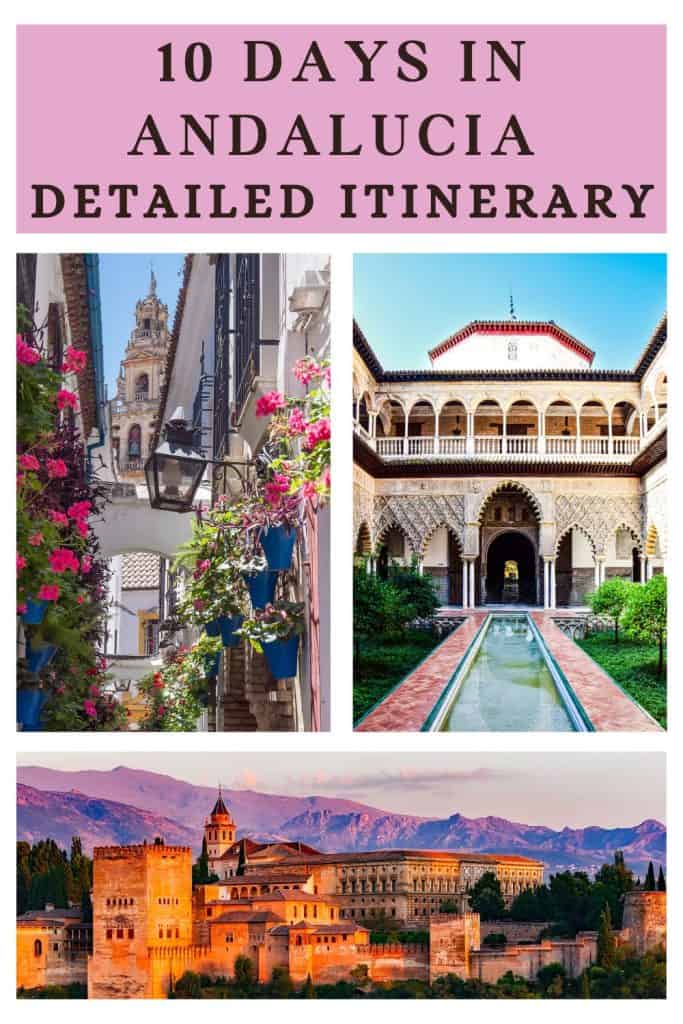
Table of Contents
How to Road Trip Andalucia in 10 days – A Detailed Itinerary
Map of Andalucia Road Trip
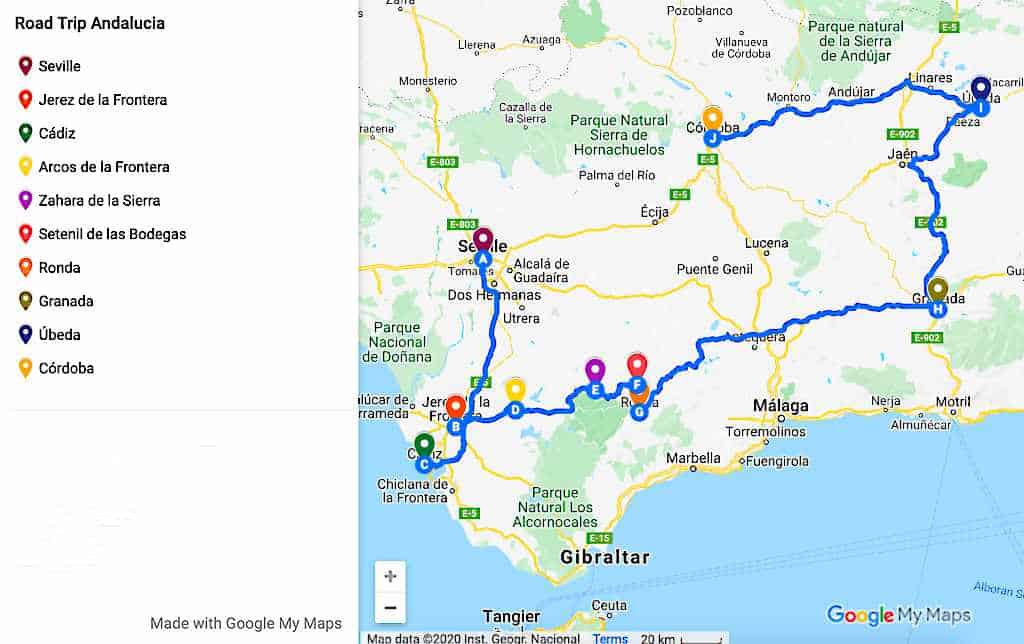
Day 1: Seville
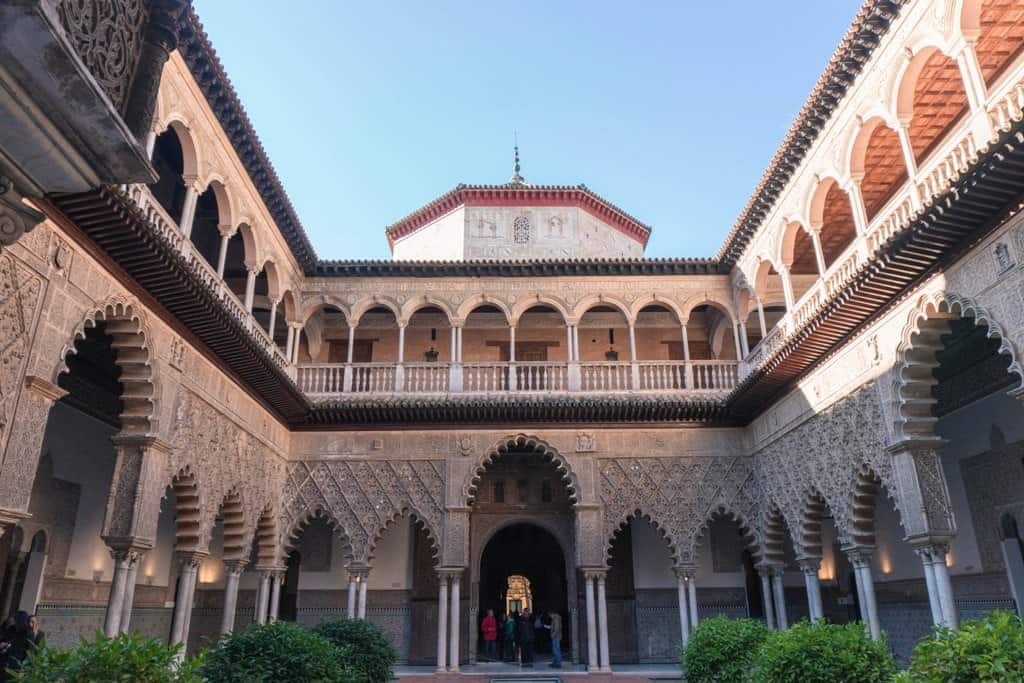
Seville is the bright and beautiful capital of Andalucia making it the ideal place to start our road trip. The place where flamenco dancing was born and combining Gothic, Renaissance, and Mudejar architecture, this is your gateway into amazing Andalucia.
Where to stay in Seville
Hotel Fernando: Situated in the historic center, the hotel offer amenities including free WiFi and modern rooms, along with a perfect location. There is also a rooftop terrace that offers incredible city views, a swimming pool for those hot summer days, and rooms with balconies!
Click here for more information and to check the latest prices.
Ribera de Triana: If you’re looking for impressive views, a rooftop pool, air-conditioned rooms, a free gym, and a spa then you’ve come to the right place. This hotel includes everything that is guaranteed to make your trip a great one! You’ll also be 20 minutes away from all of the city’s main attractions.
Click here for more information and to check the latest prices.
Visit the Royal Alcázar of Seville
Built in 913 by the Moors, this picturesque palace will have your jaw-dropping in amazement as you take in the Moorish, Gothic, Mudejar, and Renaissance architecture with geometric ceramic tiles, carved marble arches, and sunken garden courtyards.
Tip: The lines are huge to enter the Alcazar, I had friends who didn’t even get in after waiting for hours, so book your tickets and tour in advance.
Check here for more information and to book your guided tour to the Alcázar.
If you are interested in a guided tour that includes the Alcázar, the Seville Cathedral and La Giralda I recommend: Guided tour of the Alcázar, Seville Cathedral, and La Giralda.
See Seville Cathedral
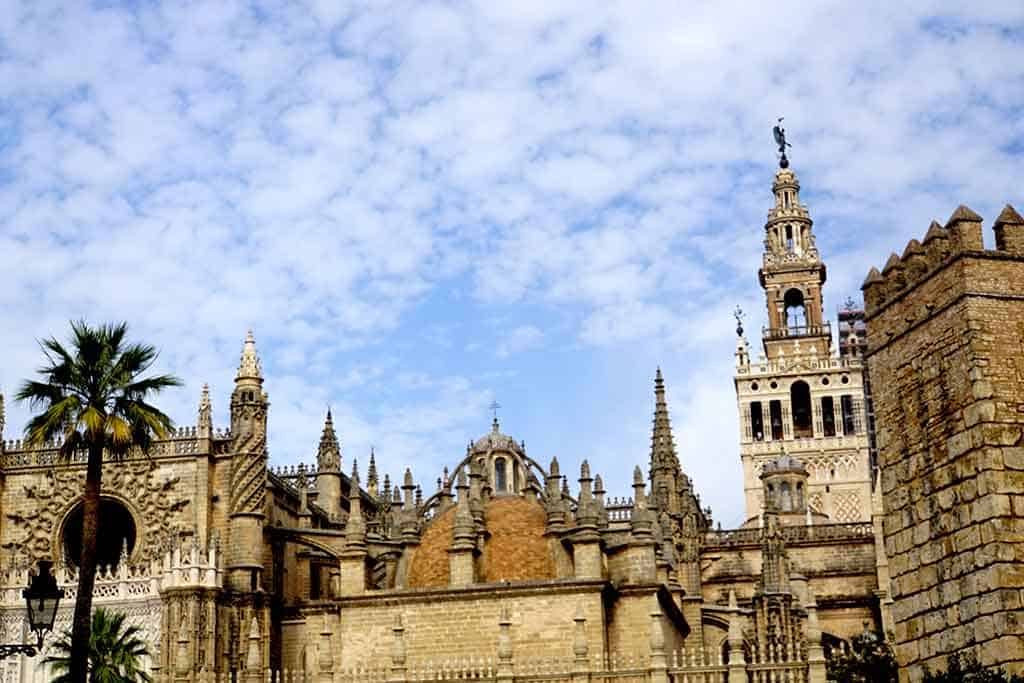
Whether you just admire it from the outside, or you take a tour inside too, know that Seville Cathedral is the largest Gothic cathedral in the world and contains the tomb of Christopher Columbus.
Opening Times: Monday 11am to 3:30pm, Tuesday-Saturday 11am-5pm, Sunday 2:30pm- 6pm. Extended opening hours in July and August until 4 pm Monday, 6 pm Tuesday-Saturday, and until 7 pm Sunday.
Cost: €9 (it includes the entrance to the Giralda)
Climb La Giralda
The Cathedral Bell Tower (La Giralda) measures 97.5 meters tall making it one of the best places to enjoy the view over the city. Access to the viewing platform is via gently sloping ramps so you won’t be too puffed out upon reaching the top!
Opening Times: Monday 11am-3.30pm, Tuesday-Saturday 11am-5pm, Sunday 2.30pm-6pm
Cost: €9 + €3 for audio guide. Optional visit to include a visit to the roof and stained glass windows: €12
Explore the Santa Cruz Neighbourhood
The former Jewish Quarter is the oldest part of the city surrounding Seville Cathedral and the Real Alcazar. Get pleasantly lost as you explore the picturesque backstreets before people watching from a cafe in a square lined with orange trees.
Visit the Torre del Oro
The 13th century 26-meter high dodecagonal-shaped military watchtower stands beside the River Guadalquivir and is today the home of the Naval Museum. Even if you’re not a museum person, the Torre del Oro is well worth a visit simply for its riverside views.
Opening Times: Monday-Friday 9.30am-6.45pm and Saturday-Sunday 10.30am-6.45pm
Cost: €3
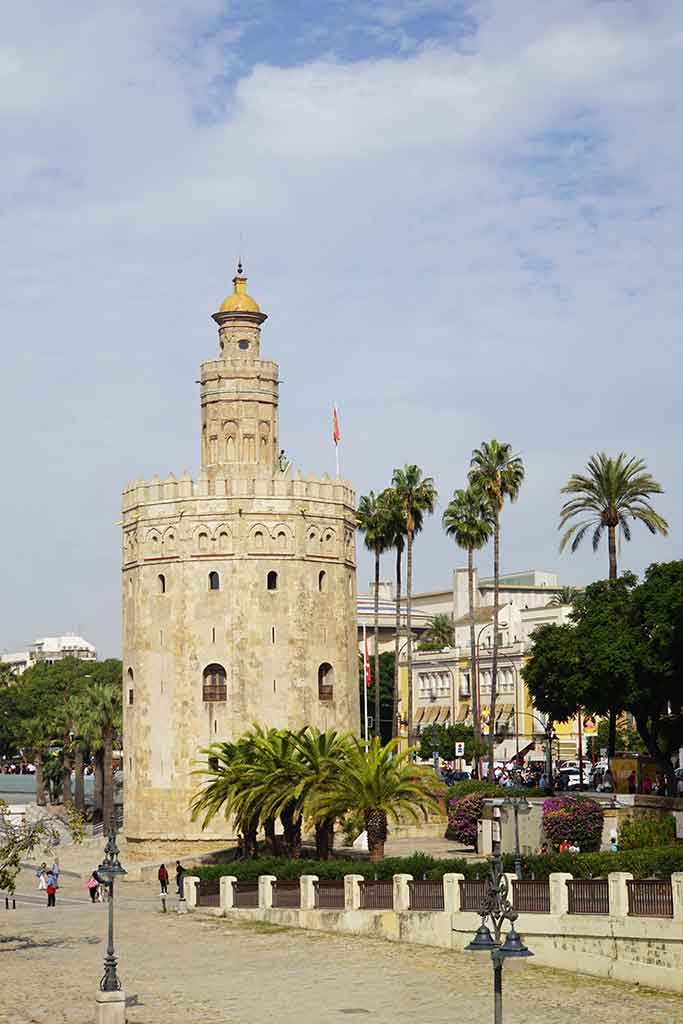
Day 2: Seville
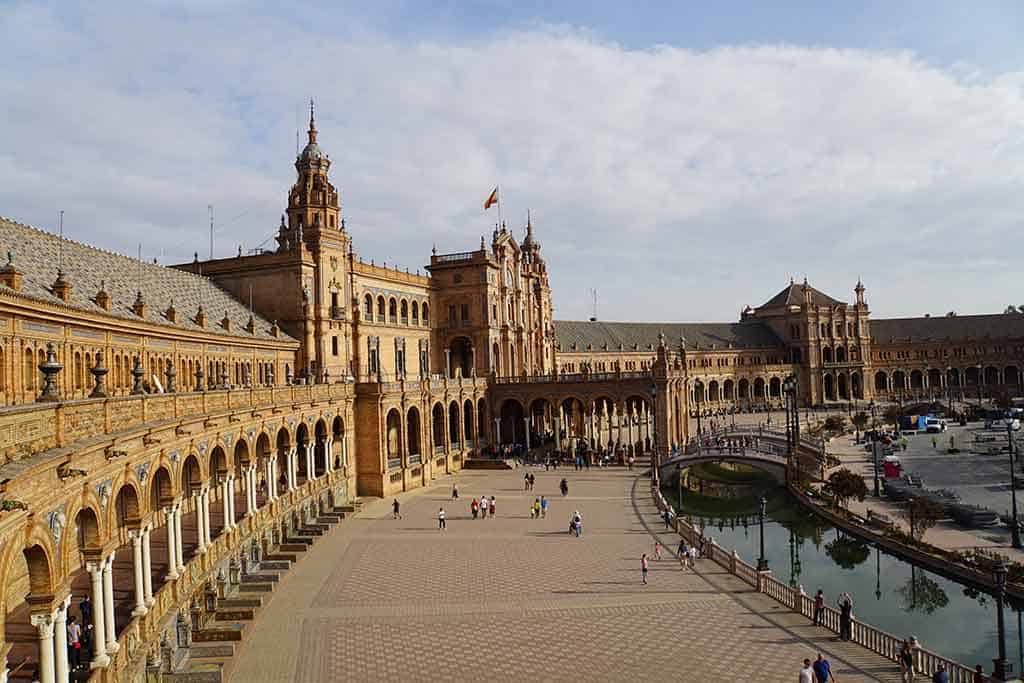
Admire Plaza de Espana
Start your day bright and early for the best photo opportunities at Plaza de Espana aka ‘the Venice of Seville’ as you take in the intricate details of this magical square with a boating canal, and ornate blue and yellow tiled bridges, mosaics, and horse and carriage rides.
Explore Parque de María Luisa
Adjacent to Plaza de Espana is a picturesque and peaceful park. Breathe a sigh of relief now that you’re away from the hustle and bustle and set out to find the Alfonso XII Pavilion, Monte Gurugu waterfall, plus the multitude of fountains, sculptures, and statues.
Head to the Museums at Plaza de América
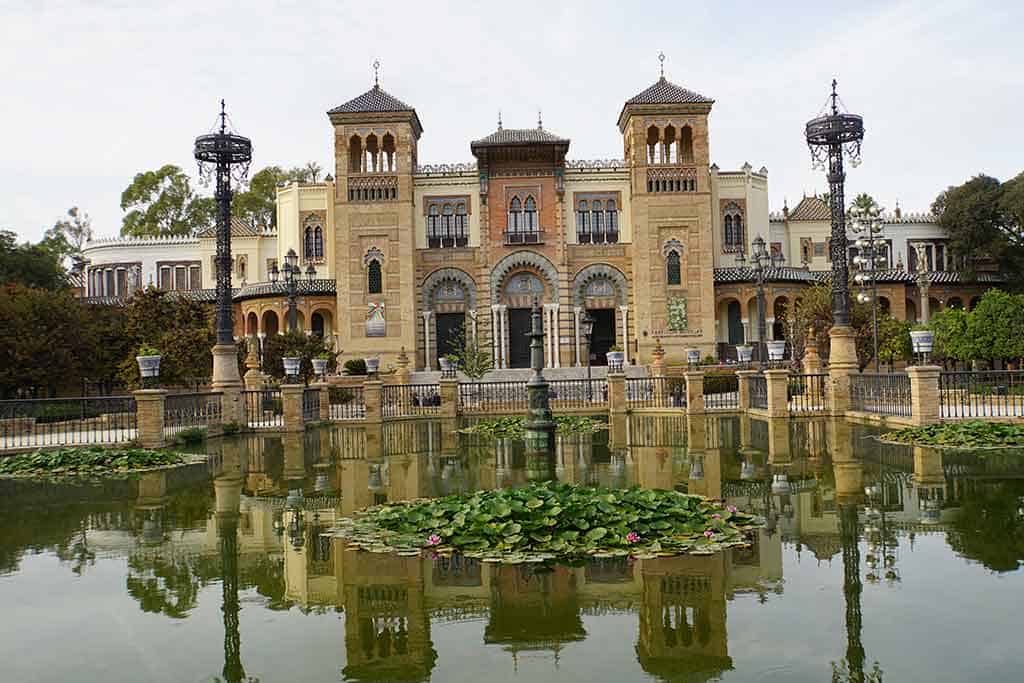
Located on the southern side of Parque de María Luisa, this square contains beautiful gardens and is surrounded by architectural gems that house some of the city’s top museums including the Museum of Popular Arts and the Archaeological Museum.
Visit the Metropol Parasol
Otherwise known as ‘the mushroom sculpture’, this modern 26-meter tall sculptural structure made from wood allows you to take in the views across the city from its rooftop walkway.
Explore Triana Neighbourhood
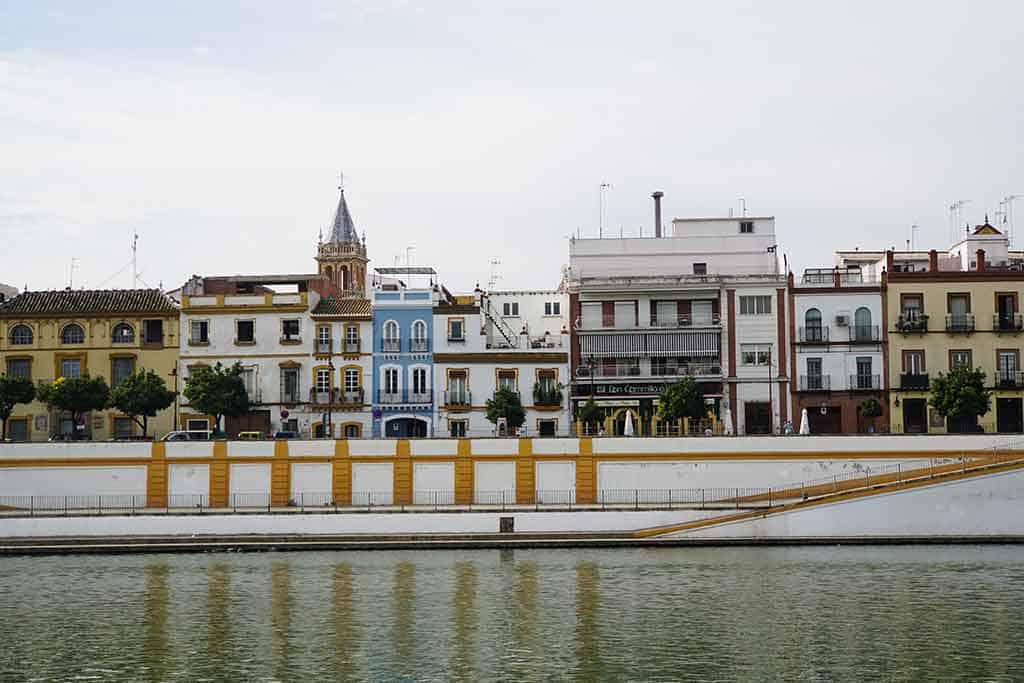
This former gypsy neighborhood is still alive with the character today. Located across the river from the main tourist attractions, Triana is a maze of backstreets containing traditional tapas bars, shops selling handmade ceramics, and lively street markets.
You might also be interested in:
How to spend one day in Seville
How to spend 2 days in Seville
The best day trips from Seville
Things to do in Seville in October
Day 3: Jerez de la Frontera and Cadiz
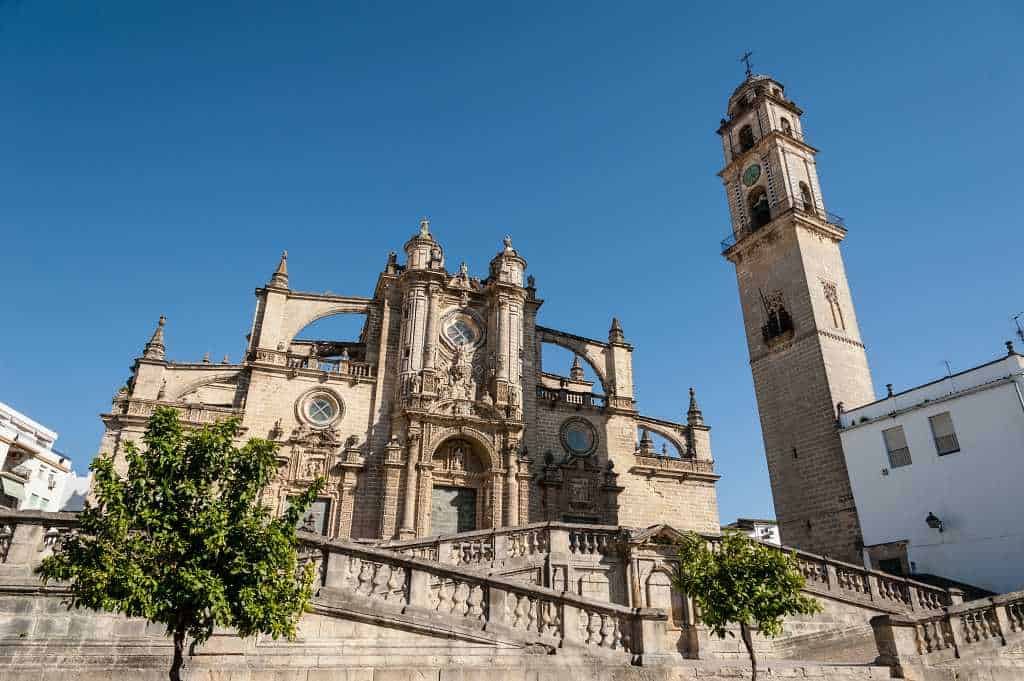
Located just over 90km south of Seville is the city of Jerez de la Frontera. Known as Jerez for short, this often-overlooked small Andalucian city is well known for its production of sherry (part of the famous sherry triangle) as well as for its horse culture and flamenco. Spend a day exploring some of its highlights…
Start in the Old Town
With an 11th-century Alcazar, a relatively new 18th-century Cathedral, a beautiful park called Alameda Vieja, and a maze of atmospheric cobbled streets full of shops, tapas bars, and sherry bars Old Jerez is well worthy of exploring.
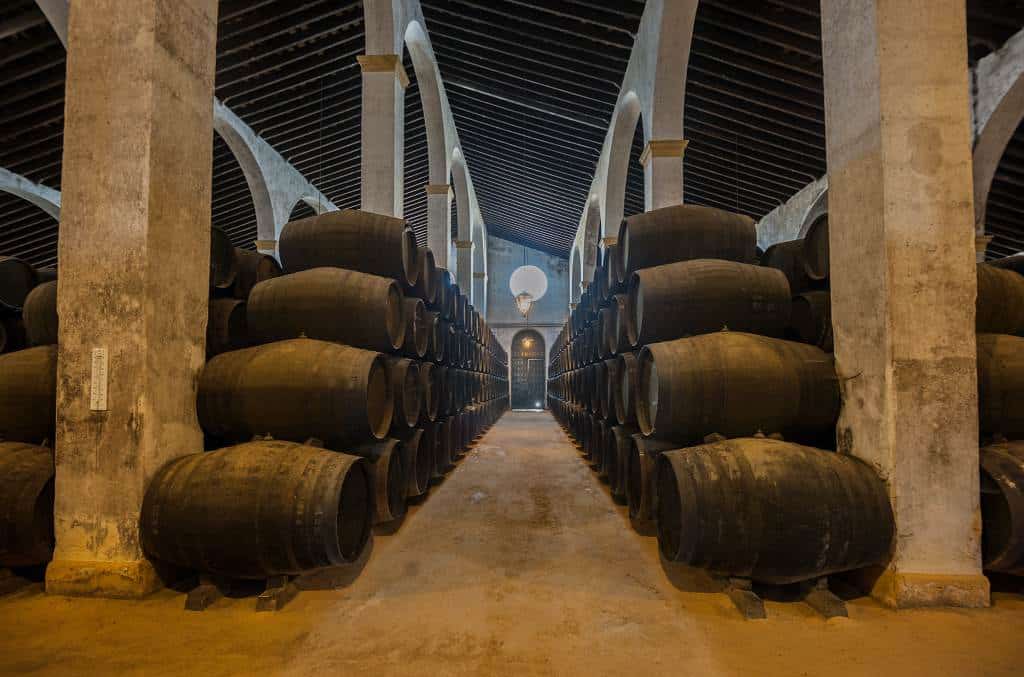
Visit a Sherry Bodega
Take a guided tour of one of the sherry manufacturers in Jerez which includes the company Gonzalez-Byass, one of the largest sherry producers in the world. Sample the drink made from palomino grapes whilst learning the long history of sherry making in Jerez.
See a Horse Show or Visit the Carriage Museum
The Royal Andalusian School of Equestrian Art preserves the equestrian arts in the Spanish tradition. A riding school plus breeder for some of the world’s finest horses, tourists can visit the carriage museum or enjoy an equestrian ballet show to see the famous Andalucian horses dancing.
Watch how the Andalucian Horses dance – click here for more info.
Carriage Museum: Monday-Friday 10:00am-2:00pm or until 3pm on show days.
Drive to Cadiz
45 minutes south of Jerez, on the South-west Spanish peninsula, you’ll arrive at the romantic port city of Cadiz. In the 16th century, Cadiz was a base for exploration and trade yet its history dates back much further, it is founded as a trading post by the Phoenicians in 1100 BC.
Day 4: Cadiz
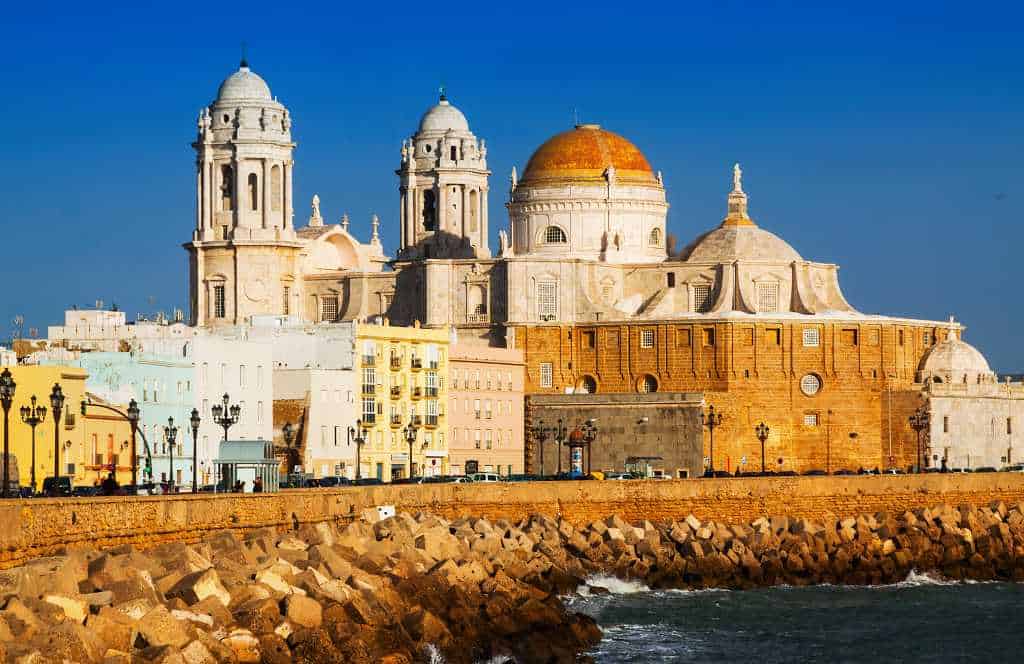
Visit Museo de Cadiz
Understand the history of this 3,000-year-old port city that was founded by the Phoenicians, conquered by the Romans, taken over by the Moors, and prospered from the 15th-18th century thanks to the discovery of America. See paintings, statues, and artifacts from the 5th–20th centuries.
Opening Times: Tuesday-Saturday from 9 am, 10 am-3 pm Sundays
Cost: €1.50 or free for EU citizens
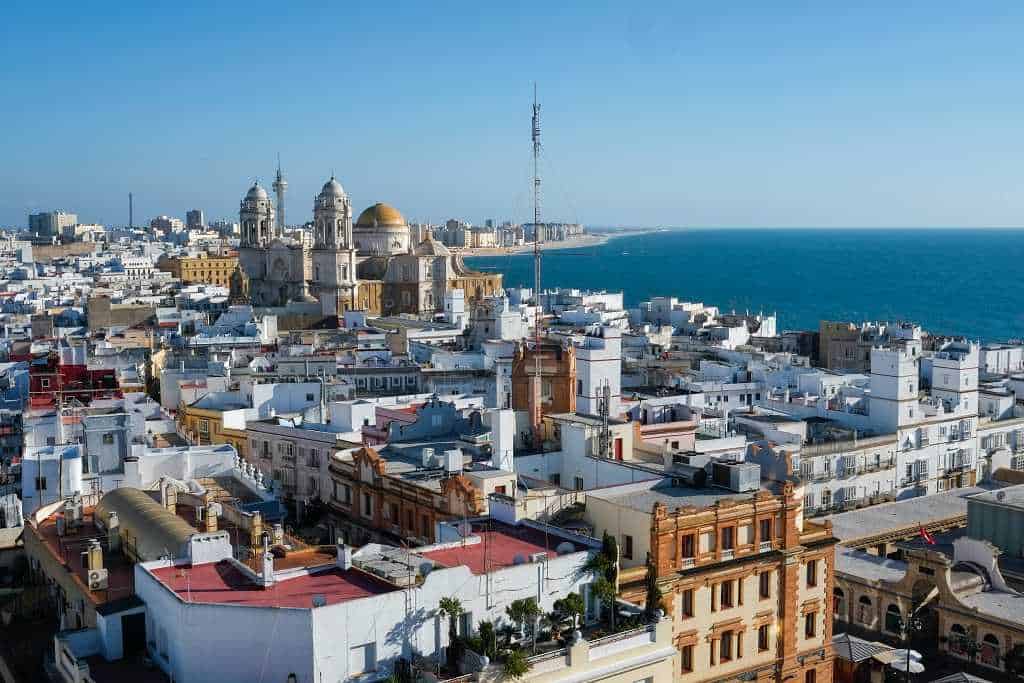
See Cadiz Cathedral
The 18th-century gold-domed cathedral is an iconic sight that cannot be missed with its baroque and neoclassical architecture. Admire it from the outside or step inside to visit the crypt of Manuel de Falla with the option to climb the Eastern tower to admire the views over the water.
Cathedral Opening Times: Tuesday-Friday 10 am-1 pm and 4.30 pm-7 pm. Saturday 10am-1pm
Cost: €5
Cathedral Tower: Daily from 10 am
Admire the View from Torre Tavira
Need another viewpoint? The city’s official watchtower, the 18th century Torre Tavira offers up panoramic views of the port and the Atlantic Ocean from its roof terrace, the highest point in the old town.
Opening Times: Open daily from 10 am
Cost: €6
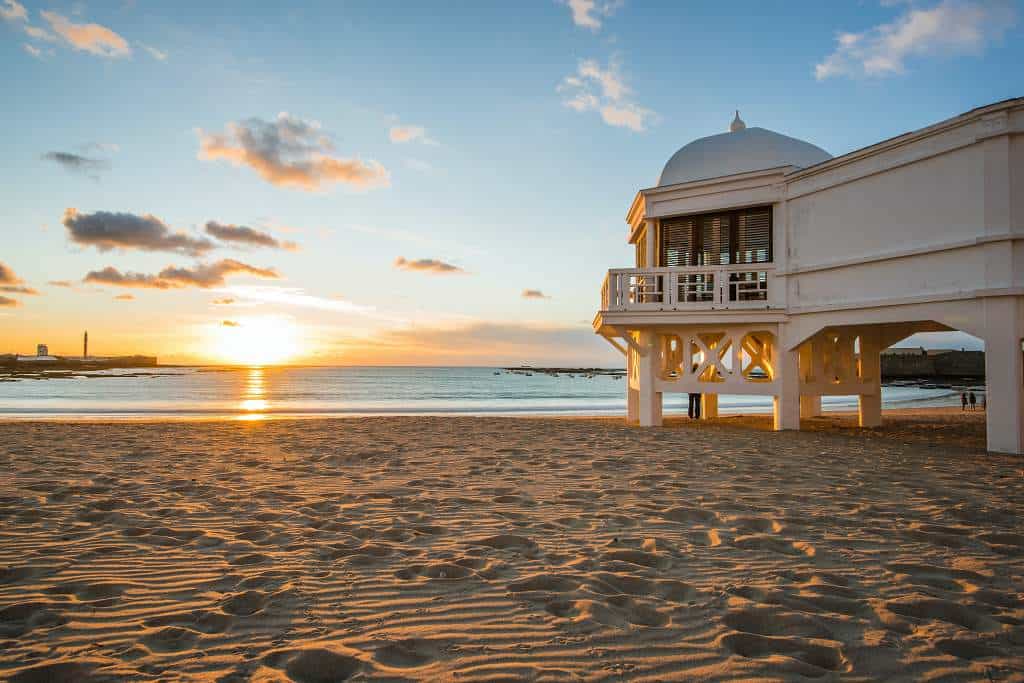
Watch Sunset from Playa de La Caleta
This beach is the place to be if you want to watch the sunset, so much so that you’ll need to arrive an hour beforehand during the Summer season to secure the best spot for watching the sun sink into the Atlantic Ocean.
Dine on Seafood
Round off your day in Cadiz with a fish supper in one of the many restaurants. Fried fish is the specialty here, sold at freidurias, but other seafood restaurants are plentiful too.
Day 5: Exploring the White Villages of Andalucia
Put your bags in the car and say your goodbyes to coastal Cadiz as you drive inland through the dramatic hilly landscapes en route to the white-washed town of Ronda, stopping off at 3 of Andalucia’s charming Pueblos Blancos (white villages) on the way.
Arcos de la Frontera
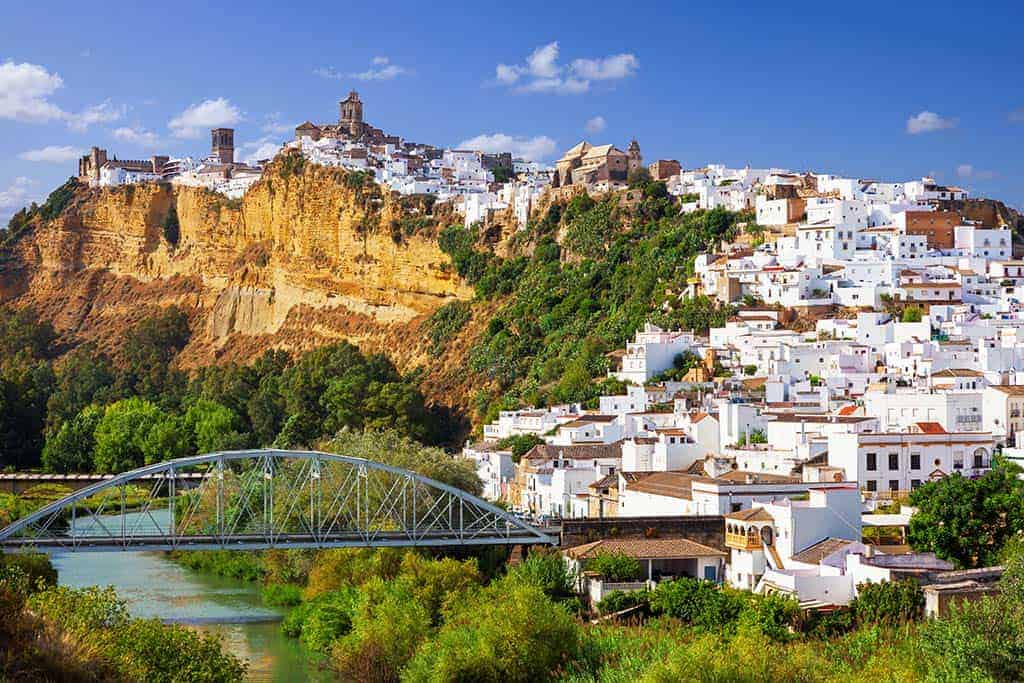
Located 45 minutes inland from Cadiz, the town of Arcos de la Frontera (Arcos for short) is one of the more famous Pueblos Blancos. Built atop a sandstone cliff with dramatic views over the surrounding countryside, Arcos de la Frontera is so-called because it was a frontier town in the Reconquista at the time of the Moors.
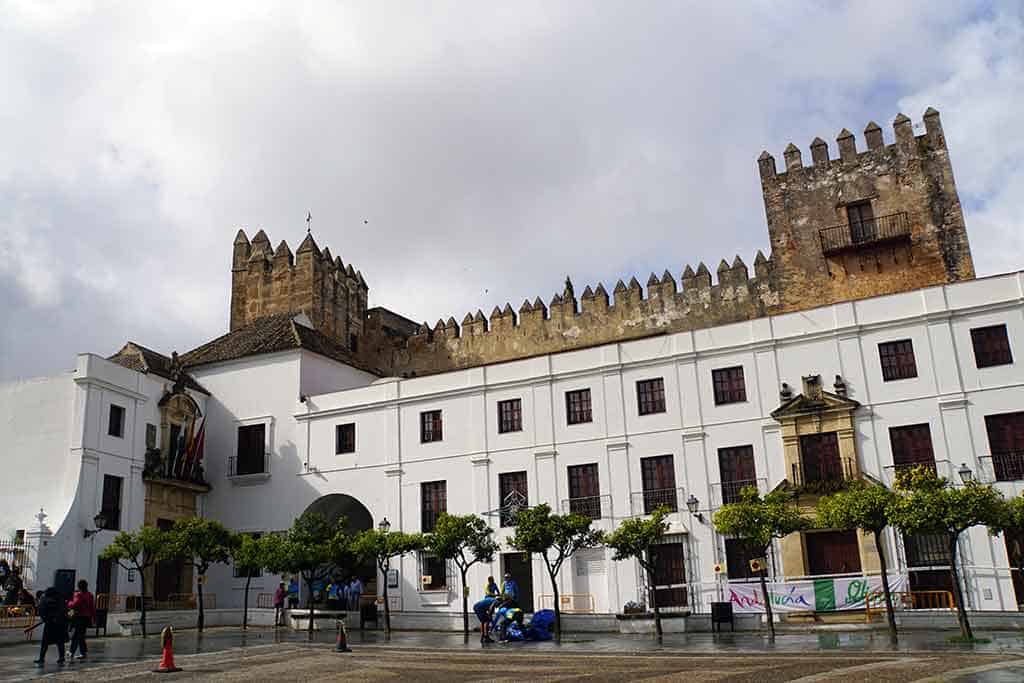
Spend your morning meandering along Arcos’ maze of cobblestone streets that lead steeply uphill to Plaza Cabildo where a 15th-century church is built on top of the remains of a Moorish fortress. You might be puffed out by the time you reach Plaza Cabildo but the views overlooking the valley below make it worth the walk!
Zahara de la Sierra
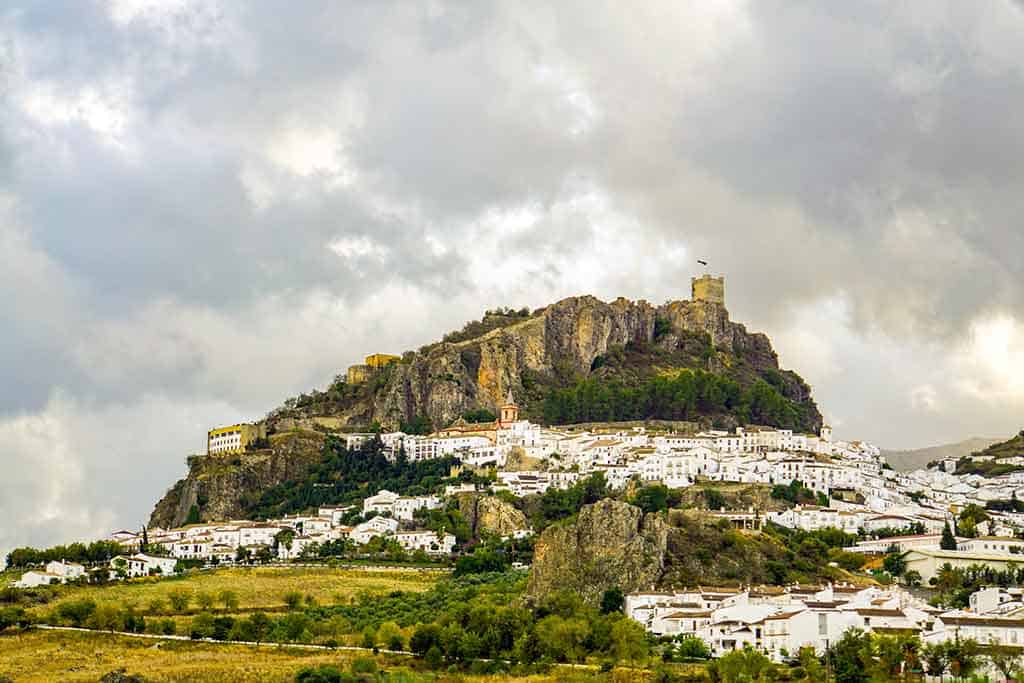
Hop back in the car and make the 50-minute journey from Arcos de la Frontera to picture-postcard-perfect Zahara de la Sierra just in time for a leisurely lunch. Built on the side of a cliff above a lake, British explorer Richard Ford described this place as a ‘Moorish eagle’s nest’ and he wasn’t wrong!
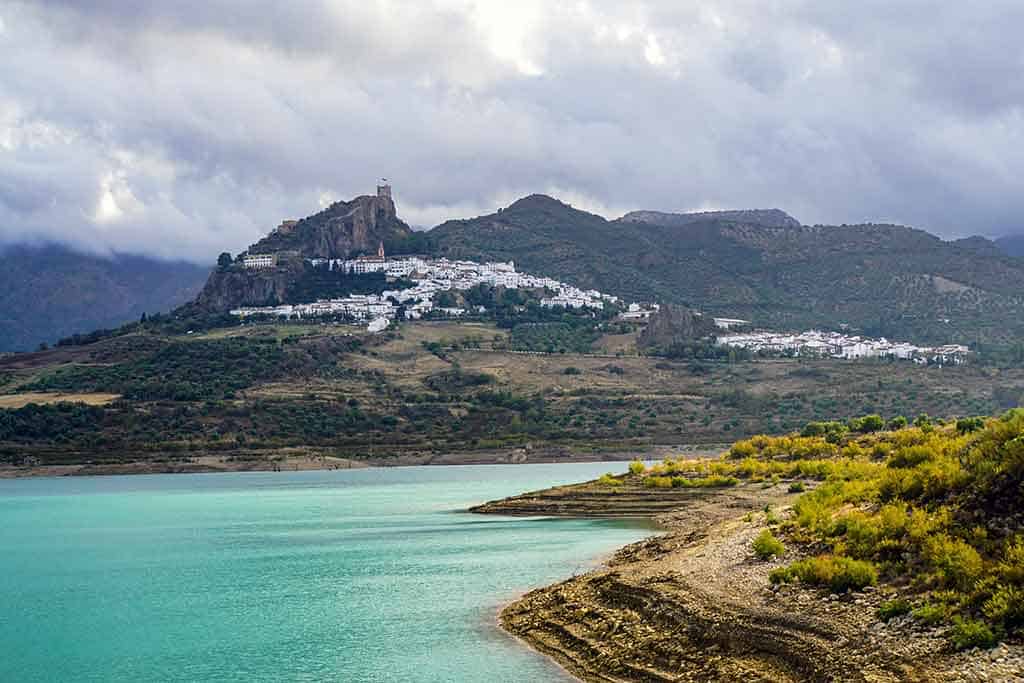
After lunch (tomato and asparagus soups are popular local dishes as are “quemones” made with a base of oil, garlic, onion and topped with a poached egg) and a spot of people watching from Plaza Mayor which is the main square with the Church of Santa Maria de la Meza, the town hall, and tourist information office, make your way up to the 13th-century Moorish fortress located above the town to take in the breathtaking views. On your way back down to the car, stop at the viewing point in the square (and perhaps a cafe and coffee?!) to take photos of Olvera, the neighboring town with the reservoir lake below – Beautiful!
Setenil de las Bodegas
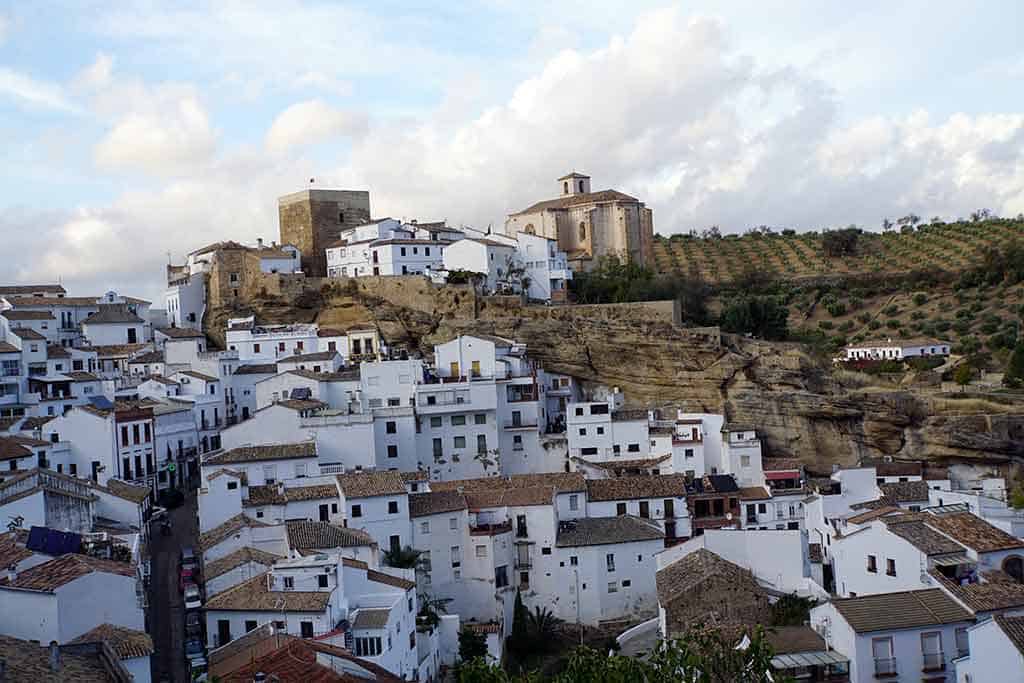
Another 45-minute journey will have you arriving in beautiful Setenil de las Bodegas in the mid to late afternoon. You might be expecting another clifftop village/town but Setenil (as it’s known for short) has developed from a network of caves in the cliffs along the Rio Trejo.
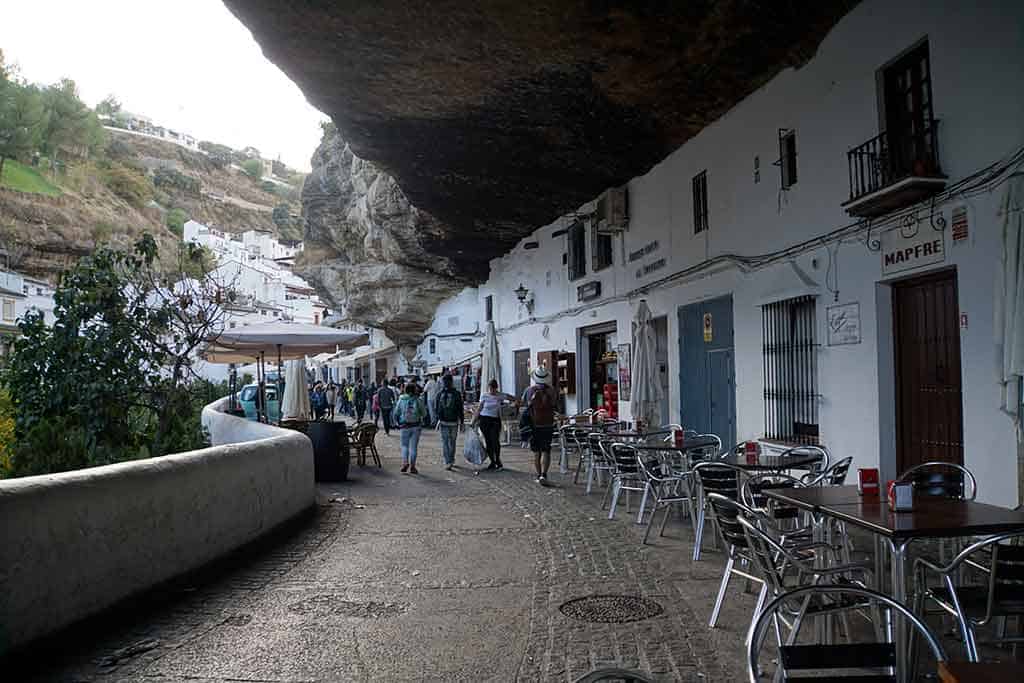
The whitewashed houses look like they are growing out of the caves and with many of them having rock roofs or roof gardens (complete with olive trees!), it’s a wonderfully unique place to spend a few hours. Wander along the steep cobblestone streets, stopping off to see the ruins of the Moorish fortress and/or the Church of the Encarnacion which is unique in that it combines Moorish and Gothic features.
Ronda
End your day in Ronda, the famous Andalucian town located 30 minutes away by car from Setenil de las Bodegas. Spend the night here, taking in the iconic El Tajo gorge and the views of the Puente Nueve (New Bridge) lit up at night from Mirador de Aldehuelaand/or Mirador de Los Viajeros románticos. Find somewhere to enjoy a relaxing dinner that takes in the view before falling into bed after one very incredible day of sightseeing – You’ll have time to explore Ronda more tomorrow!
You might also like: A guide to Pueblos Blancos of Andalucia.
Day 6: Ronda
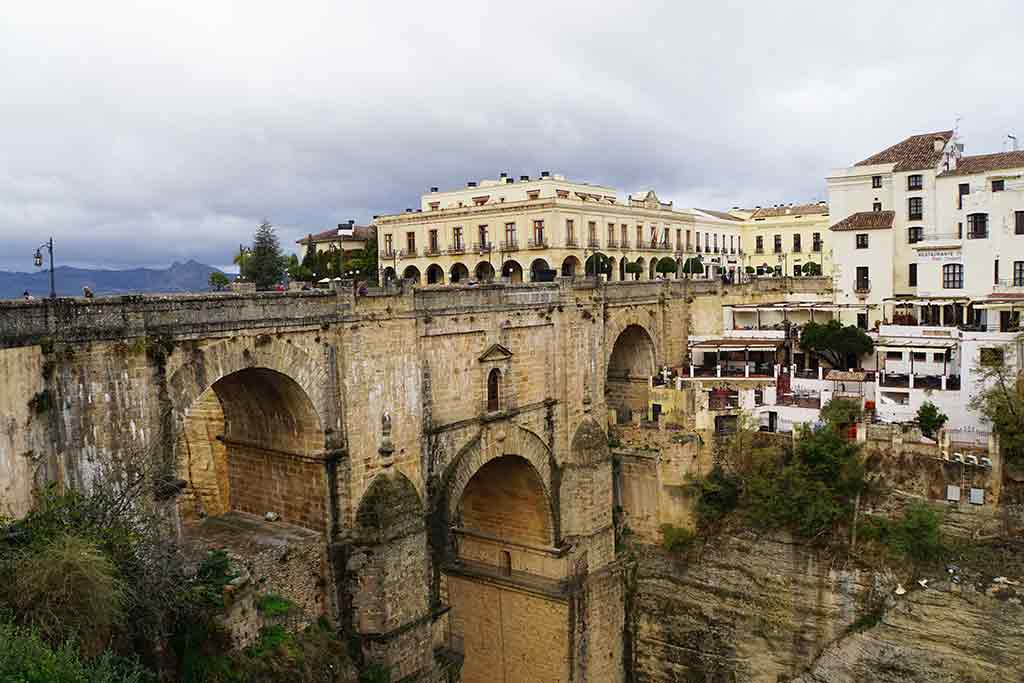
Walk Through Alameda del Tajo Park
These beautiful botanical gardens date back to the 19th century and contain a wide variety of trees, plants, and flowers. Watch the locals going about their day, find and photograph the fountains, and admire the view of the valley below.
Stand at Mirador de Ronda
This iconic viewing platform juts out over the valley offering panoramic vistas of the El Tajo gorge, mountains, and Puente Nuevo – Have your camera at the ready, and be ready to smile for your selfie!
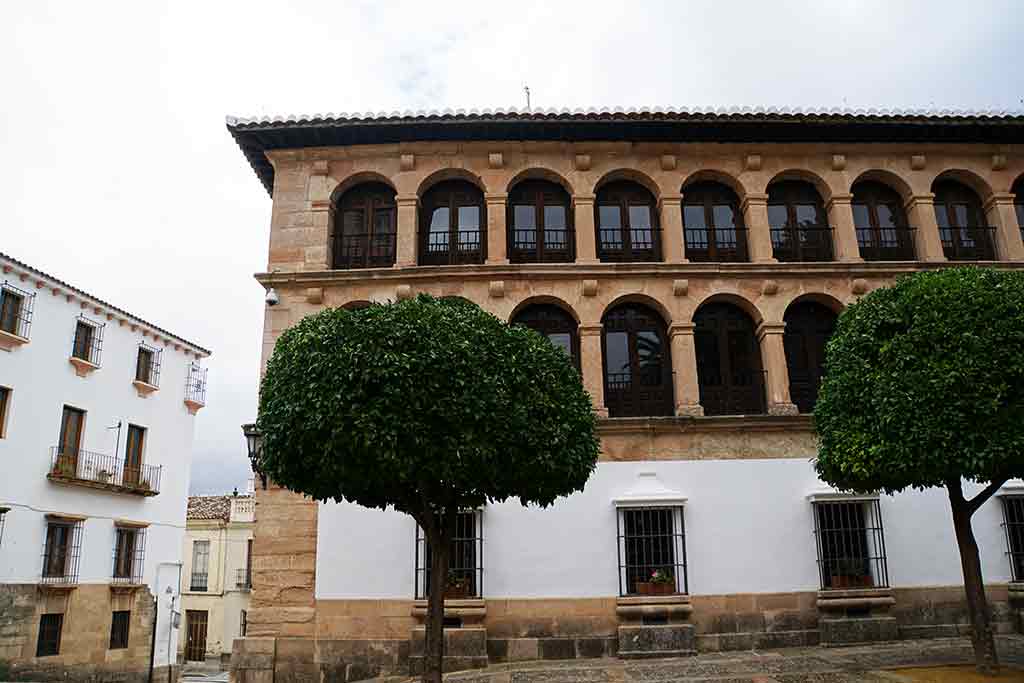
Hike El Tajo Gorge
You would have admired the view of Puente Nueve towering above you last night, but go back in the daytime and consider doing the hikes from this lower viewpoint – The shorter hike takes you under the bridge to the old water mill whilst the 2nd takes you down the valley.
Step back in time at Banos Arabes
The remains of these Arab baths date back to the 13th-14th century and are in remarkably good condition – Admire the horseshoe arches and columns as you peer up to see the star-shaped holes in the roof.
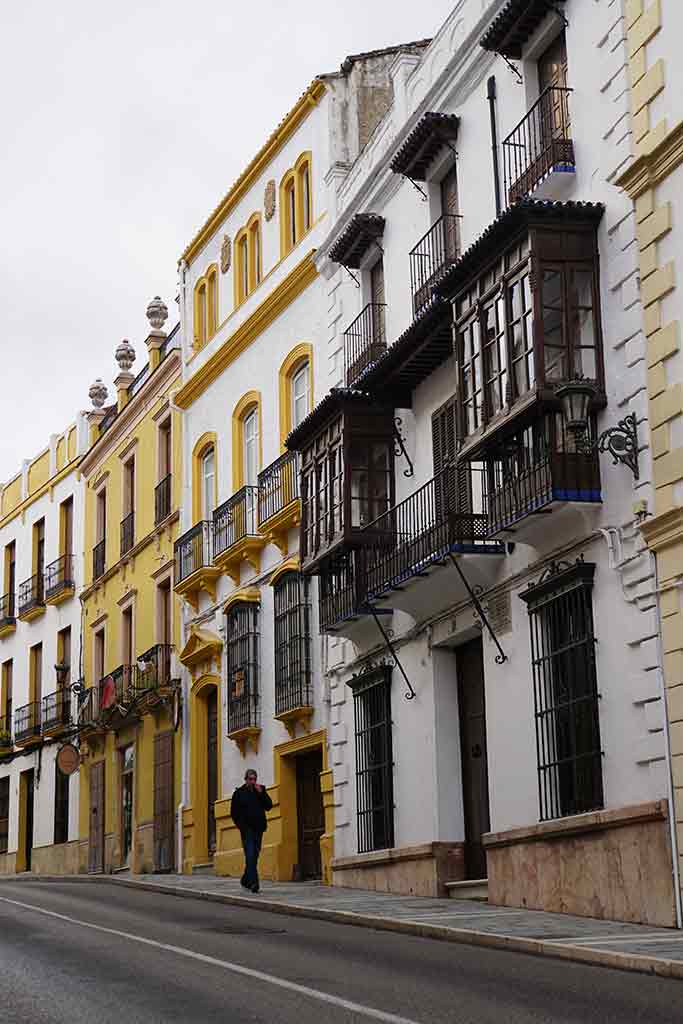
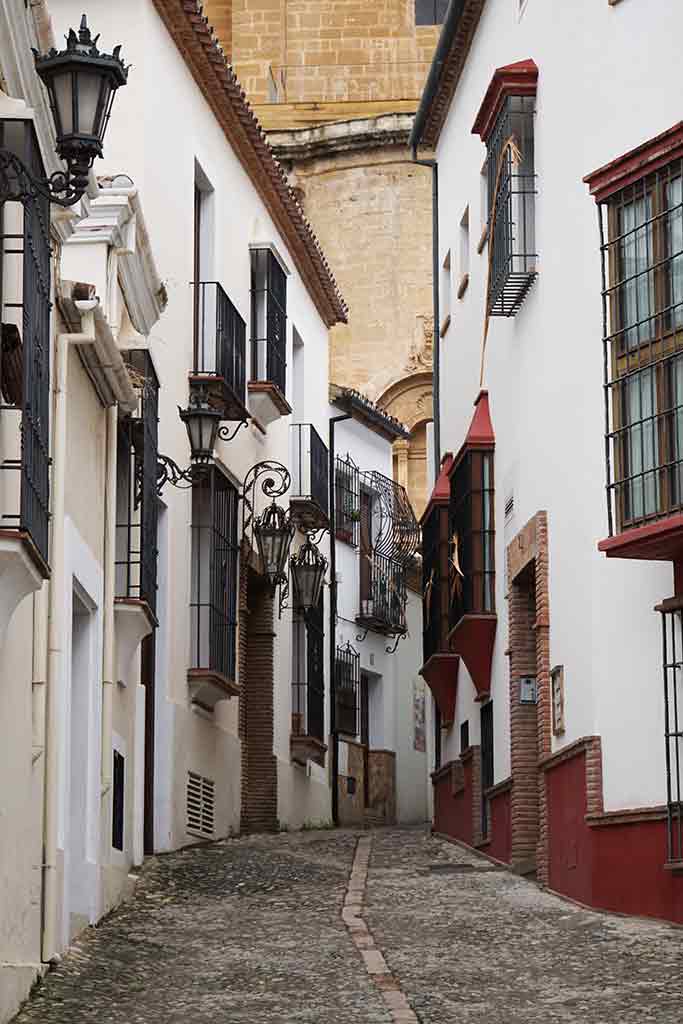
Marvel at Mondragon Palace
The former home of King Abbel Malik and Hamet el Zegri, the last Arab governor, this stunning palace gives visitors a fascinating insight into the history of Ronda with its artifacts and architecture.
Admire Iglesia de Santa Maria la Mayor
This 14th-century church has a beautiful white and yellow facade, admire the exterior as you sip on a coffee in the square, or pop inside and discover the rich and varied history, this church standing on a Visigoth structure.
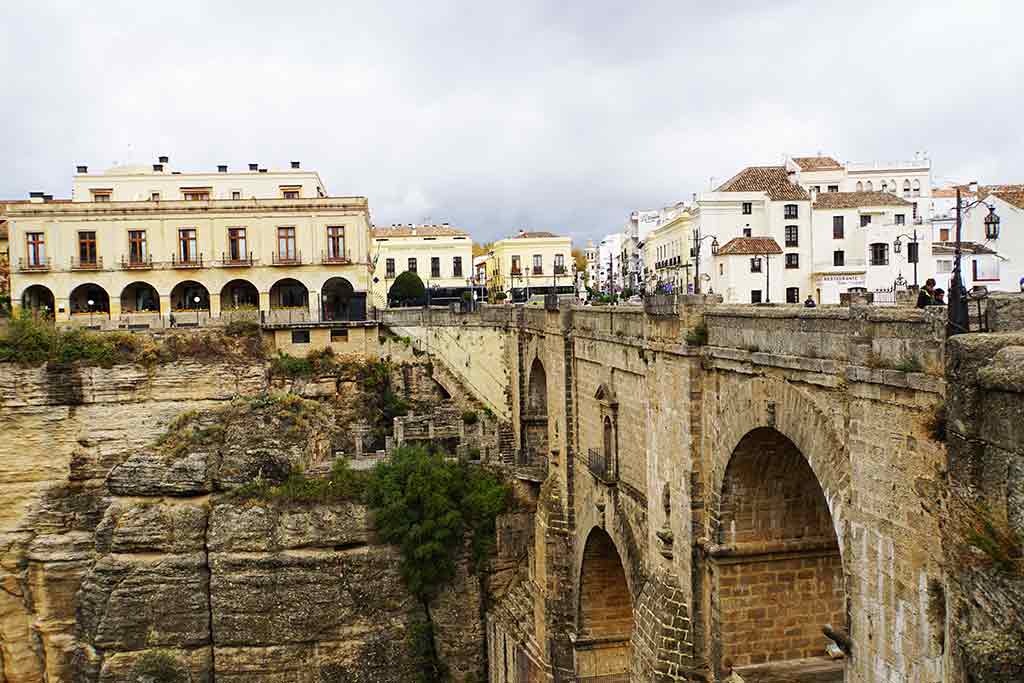
Wander Through Cuenca Gardens
Walk through the clifftop patios admiring the breathtaking scenery and historic architecture as you make your way to Puente Viejo, the smallest and oldest bridge that crosses the gorge.
Say goodbye to Ronda and prepare for a 2-hour twenty-minute drive to the foothills of the Sierra Nevada mountains where the city of Granada, with its 700 years of Moorish heritage is waiting to captivate you.
You might also want to check out: Things to do in Ronda
Day 7: Granada
Where to stay in Granada
Gar Anat Hotel Boutique It gives off a vibe of Granada’s architectural spirit but also has calm, cool, and beautiful rooms with a Granada-styled courtyard for your morning cup of coffee. The hotel is also 5 minutes away from Granada Cathedral.
Click here for more information and to check the latest prices.
Hotel Granada Center: One of the most renowned hotels in Granada, the Hotel Granada Center is only 10 minutes away from the old town and has free Wi-Fi, great rooms, and an a la carte restaurant. You’ll also be 10 minutes from the Granada Cathedral!
Click here for more information and to check the latest prices.
Visit The Alhambra & Generalife Gardens
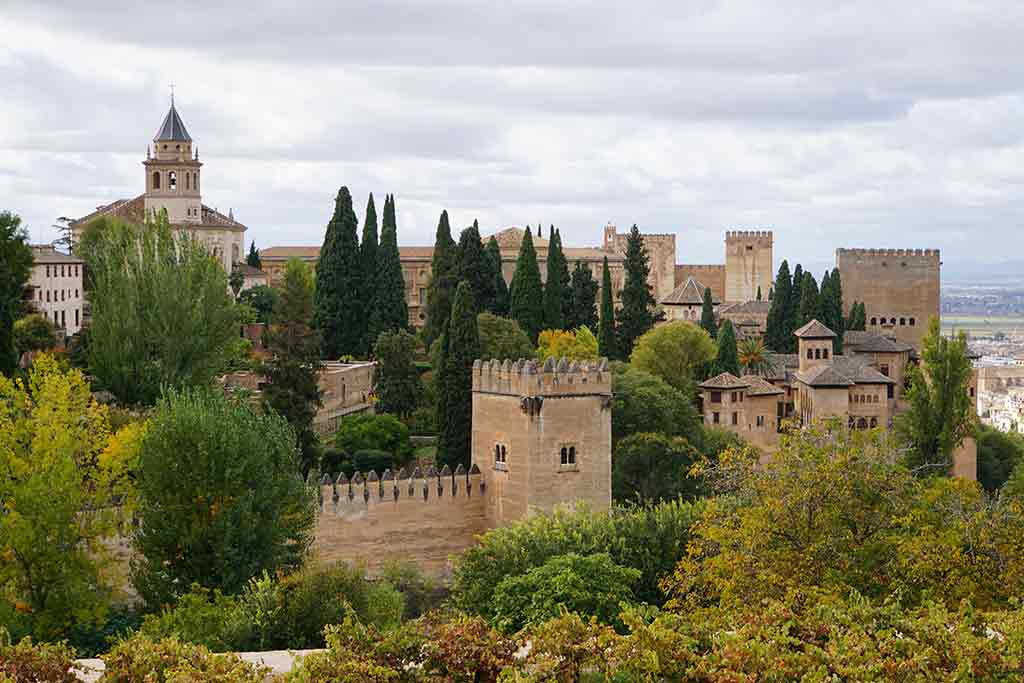
This famed hilltop fortress is huge, the ancient enclosed town made up of royal palaces, the iconic reflecting pool, patios, and the sprawling orchards and stately gardens of the equally massive Generalife gardens, you can easily spend the best part of the day here.
TIP: It is very important to book tickets in advance! If you can, book your entry time at least a month out from your intended visit. You must specify a specific time when booking your ticket, so make sure you purchase a ticket for when you know you can get there, otherwise, you won’t be allowed in.
A guided tour is often better at a place like the Alhambra because you have the added benefit of a local guide who can share the history and facts, as well as legends, of the Alhambra and its surroundings. You can choose from a skip the line guided tour to the Alhambra Palace and Generalife Gardens or book your tickets online and explore on your own.
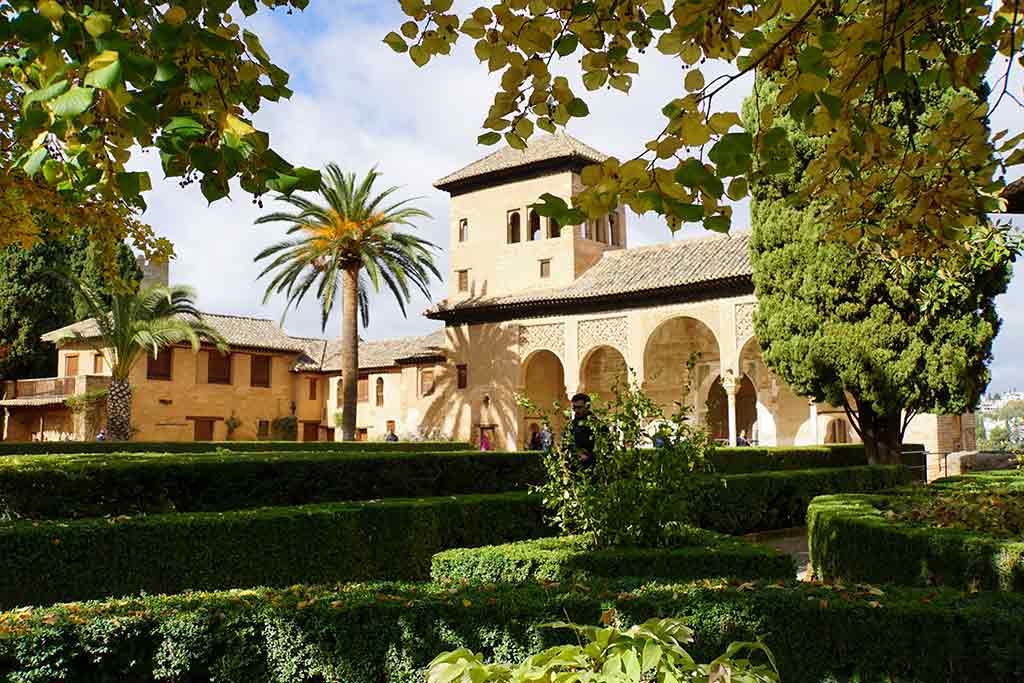
Explore the Albaicin Neighbourhood
Granada’s historic Arab quarter will make you think you’ve taken a wrong turn and have somehow arrived in Morocco! Explore the narrow alleys with hand-painted Moorish tiles adorning the houses and shop at the remaining street of the 15th-century Grand Bazaar known as the Alcaiceria.
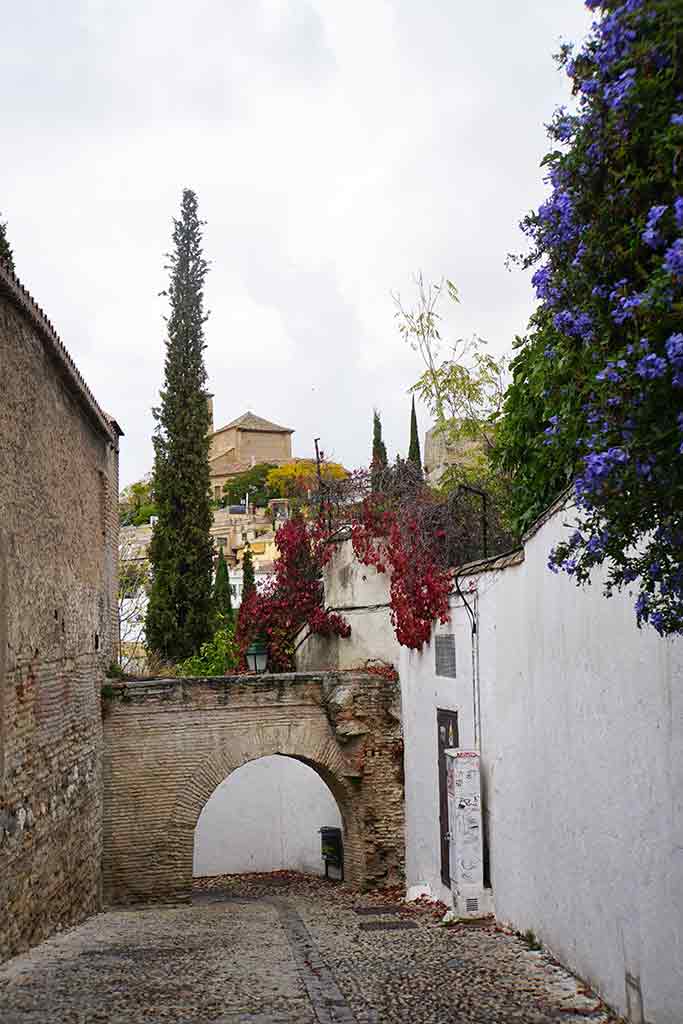
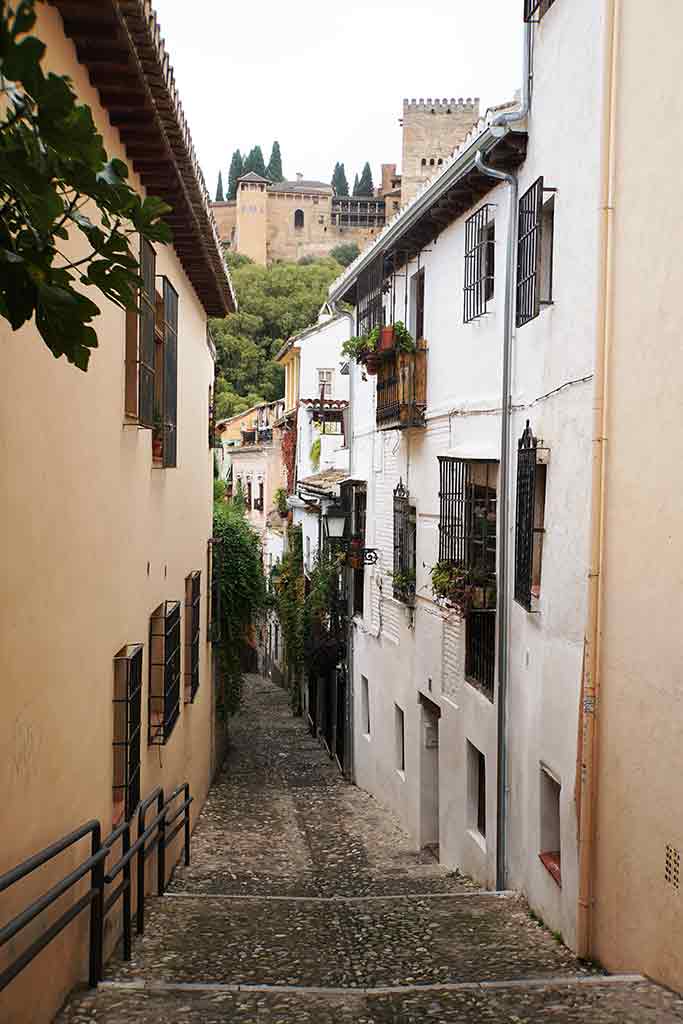
Watch Sunset at Mirador de San Nicolás
End your day of sightseeing at the most famous and most picturesque viewpoint in the city and watch the sunset behind the mountains and the Alhambra. Get there early to secure your spot on the wall for the best views!
Day 8: Granada
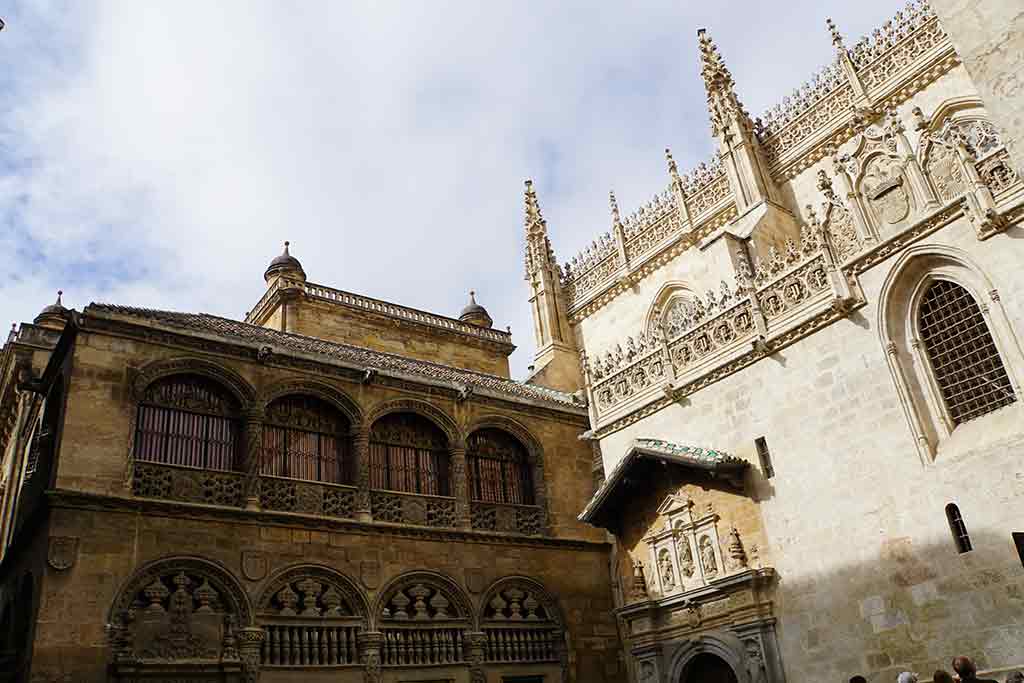
Admire Granada Cathedral
This 16th-century cathedral is the 2nd largest cathedral in Spain and stands on the ruins of the old Mosque from the Nasrid Empire. Step inside to see the renaissance interior with beautiful stained glass windows, sculptures, and paintings.
Visit the Royal Chapel
Next door to the cathedral is the resting place of two of Spain’s most important rulers, the Catholic Monarchs Isabella I and Ferdinand II who completed the Christian re-conquest of Spain in the 1400s.
See Granada’s El Bañuelo
If you run out of time to see the Arab baths in Ronda, be sure to see them in Granada. These well-preserved baths date back to the 11th century, located below a private home.
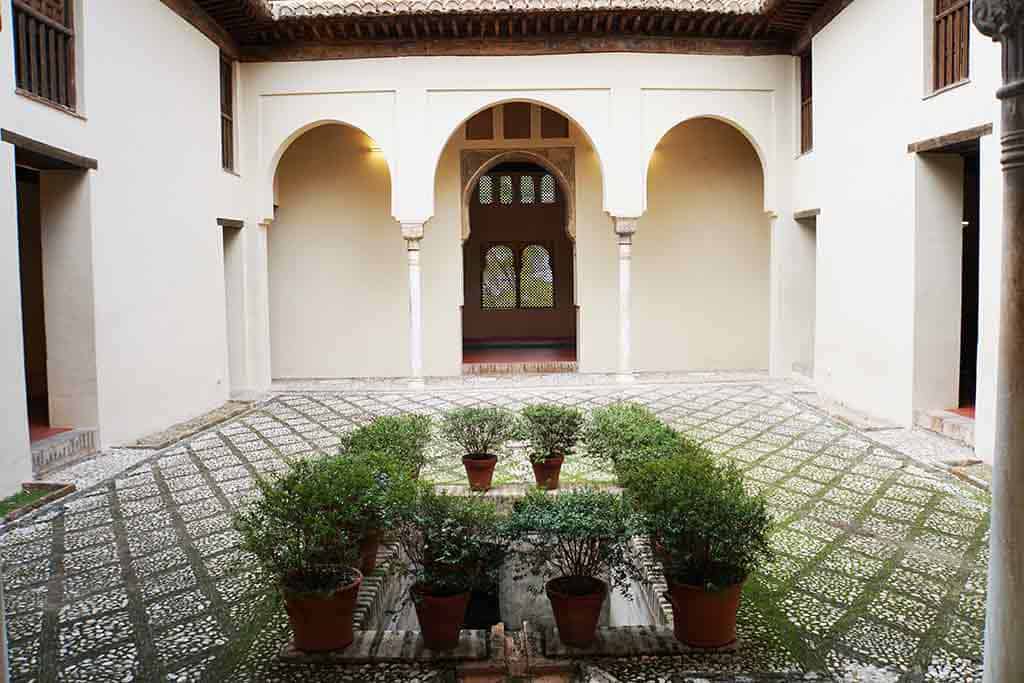
Step inside Horno de Oro
This is one of the best-preserved Mirisco (Catholic Moorish) houses in the city. With a delightful enclosed courtyard, see what a traditional Arab house looks like and admire the views of the Alhambra.
Tourists can buy the Monumentos Andalusíes ticket on the Alhambra webpage, which will allow you to visit the Bañuelo, the Dar al-Horra Palace (in the Albaicin), the Horno de Oro House, and the Corral del Carbón. This joint ticket costs only 5 euros, but entry to these monuments is free on Sundays.
Explore the Sacromonte Neighbourhood
The home of the city’s gypsy community who were forced to make their home amongst the caves after the city was retaken by the Catholic Monarchs in the 16th century, this area is still lively today with flamenco performances taking place inside some of the cave houses – An ideal way to end your time in Granada.
You might also want to check out: How to spend 2 days in Granada.
Day 9: Cordoba via Ubeda
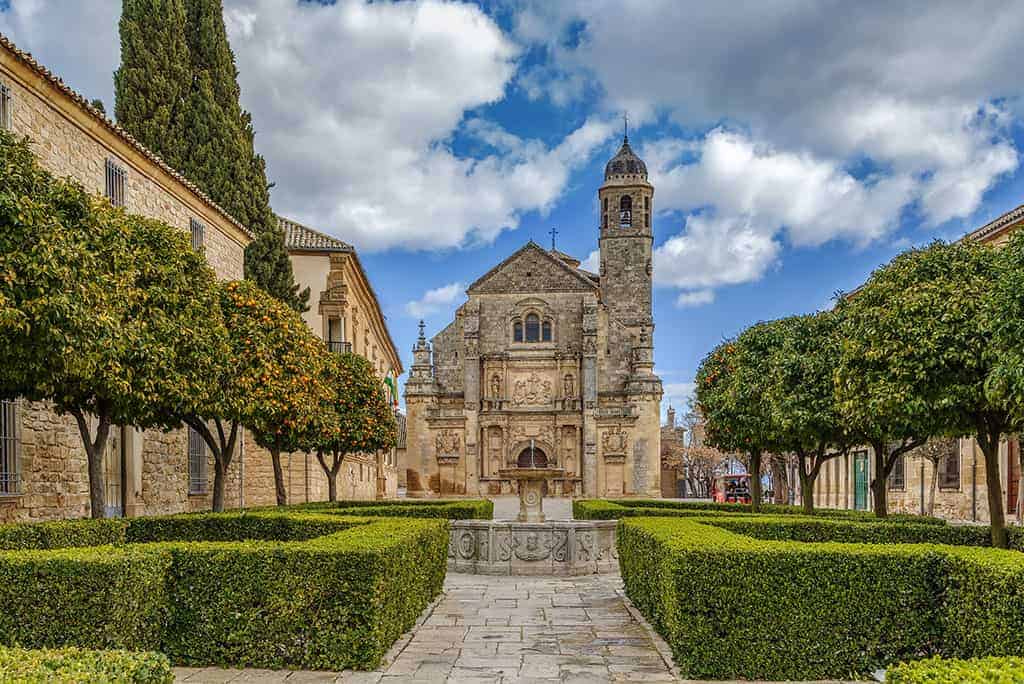
En-route from Granada to Cordoba, take a detour to the town of Ubeda for a couple of hours to see Spain’s purest examples of delightful renaissance architecture in what is known as the ‘Florence of Andalucia’.
Ubeda – Plaza de Vázquez de Molina
Sip on a coffee in this monumental square surrounded by the most imposing 16th century Renaissance buildings as you take in the view of the Las Cadenas Palace (aka, the Palace of Marquis de Mancera) the El Salvador Chapel, and the Santa Maria de Los Reales Alcazares church, deciding which if any you want to see inside.
Ubeda- Visit the Olive Oil Museum
The Centro de Interpretacion del Olivar de Ubeda is a great alternative to visiting more palaces and churches – Here you can taste several varieties of olive oil whilst learning the history of olive oil production in Ubeda.
Ubeda – Visit the Pottery Museum
Located in Barrio San Millan, the town’s pottery neighborhood, the Museo de Alfareria Paco walks you through the traditions of this craft, explaining the processes for which Ubeda and its 2 most famous potters are known worldwide.
After your renaissance detour, arrive into Medieval Cordoba in the late afternoon and feast your eyes on the melting pot of Roman and Moorish architecture and the delightful flowering patios.
Where to stay in Cordoba
Hesperia Cordoba This 4-star boutique-style hotel is in a superb location on the banks of the River Guadalquivir with views of the Alcazar and Mezquita, all of these attractions and more a short 5-10minute walk away. With a seasonal pool on the roof, on-site restaurant-bar serving regional food, and gym it provides comfortable accommodation for couples looking to explore the city.
Click here to check availability and the latest prices.
Hostal Esencia de Azahar: Located in the heart of the picturesque Old Jewish Quarter, just a 5-minute walk from the Mezquita, this elegant guest house has a roof terrace where you can sit and soak up the sun whilst admiring the view across the city rooftops before heading out to explore all the sights which are within walking distance, though if you prefer, there is a bus stop close by.
Click here to check availability and the latest prices.
Mosque-Cathedral of Córdoba – Mezquita
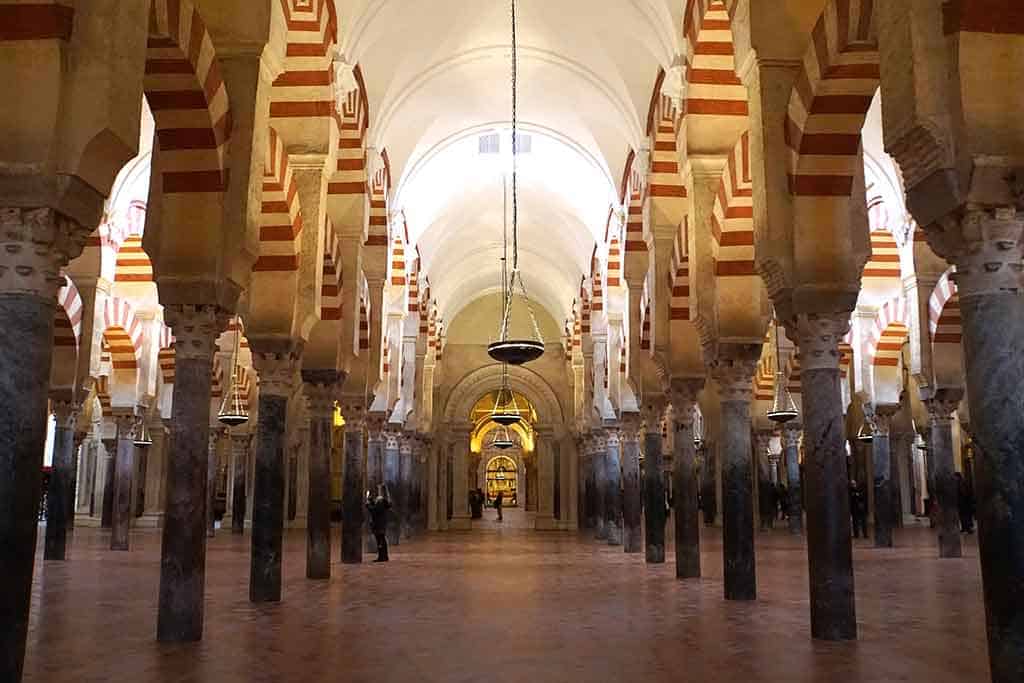
This 10th-century mosque-cathedral (half Moorish, half Renaissance) will dazzle you with its intricate designed facade with golden doors but just wait until you step inside and see the iconic 850 red and white columns in the prayer hall!
Opening Times: March-October10am-6pm Monday-Saturday and on Sunday’s 8.30am-11.30am and 3pm-7pm. November-February 10am-6pm Monday-Saturday and Sunday’s 8.30am-11.30am and 3pm-6pm.
Price: €10
Click here to book a guided tour to Cordoba’s Mosque-Cathedral.
Explore the Jewish Quarter
Walk the streets lined with orange trees, explore the maze of quaint backstreets admiring the architecture, see the churches and a 14th-century synagogue, enjoying the thrill of what’s around the next corner as you keep within the boundaries of the historic city walls.
Plaza de la Corredera
Once the place of public spectacles including bullfighting and executions, this grand-looking plaza with its arched porticos makes a lovely spot to enjoy a bite to eat whilst people watch and rest their weary feet.
Roman Bridge
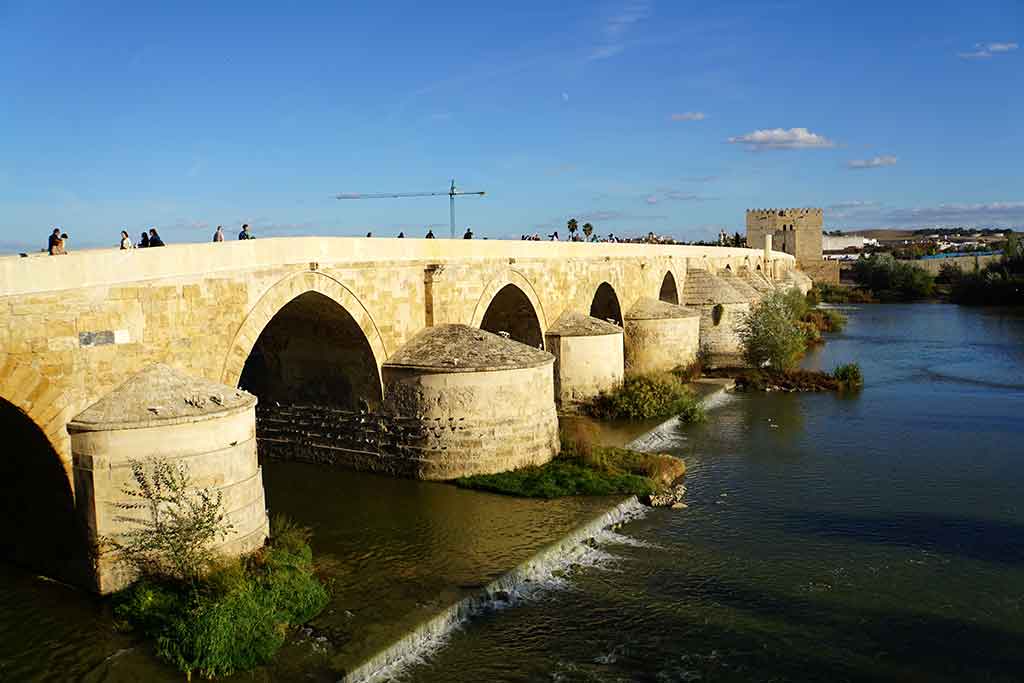
Catch the sunset from the 16-arched Roman Bridge that crosses the Guadalquivir river. Lit up at night, the bridge which leads to the tower in one direction and the gate and Mezquita in the other is the spot to admire the most historic sights of Cordoba.
Day 10: Cordoba
Calleja de las Flores
Get up bright and early so that you can enjoy the most iconic and picturesque street in Cordoba, the “alley of the flowers” to yourself, without the hoards of tourists.
Alcazar de los Reyes Cristianos
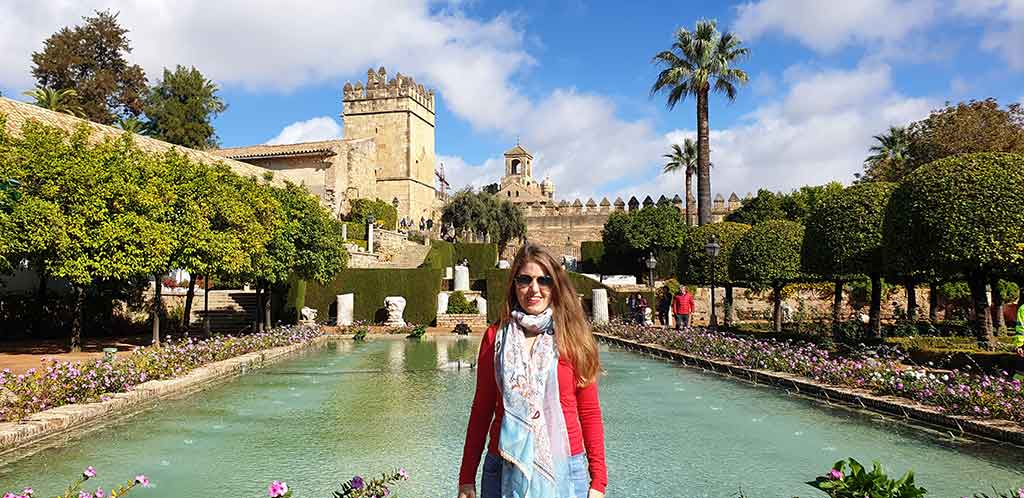
The main residents of the Catholic Monarchs, Isabella I and Ferdinand II, wander the hallways of this palace-fortress before stepping out into the landscaped gardens with orange trees and reflective pools that will take your breath away.
Opening Times: Tuesday-Sunday 8.45 am-3.15 pm
Price: €5
Click here to book a guided tour to Cordoba’s Alcazar.
Torre De Calahorra
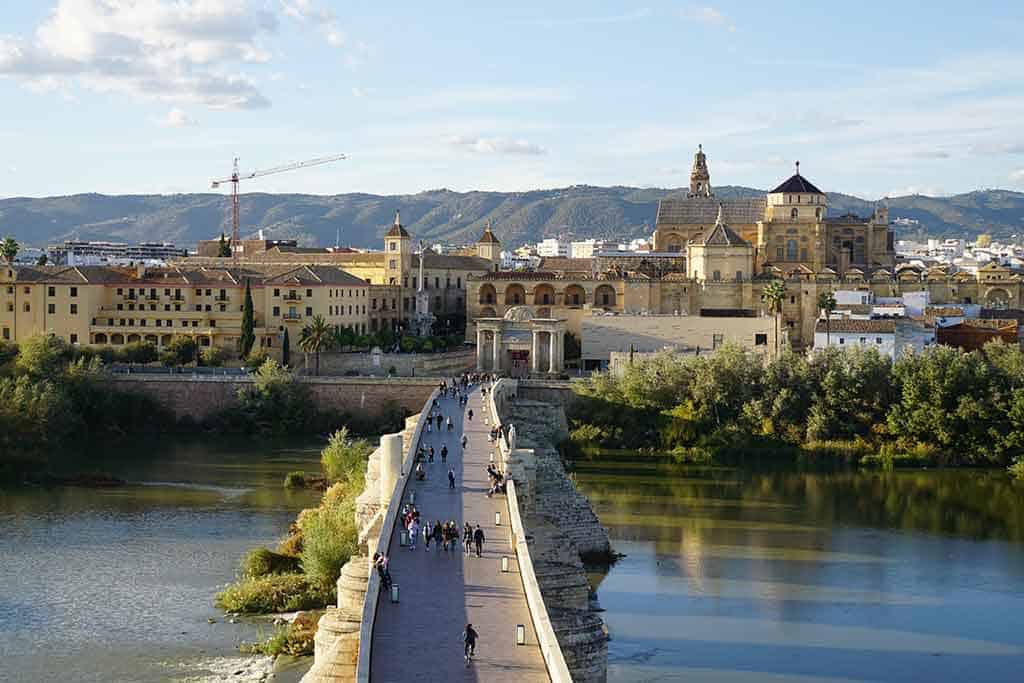
Step inside the 12th-century defense tower and discover the history of Cordoba at the Vivo de Al-Andaluz museum. Learn how the Muslims, Christians, and Jews lived side by side in peace in Cordoba.
Opening Times: May-September 10am-2pm and 4.30pm-8.30pm, October-April 10am-6pm. Video projections at 11am, 12pm, 1pm, 3pm, 4pm
Price: €4.50
Palacio de Viana
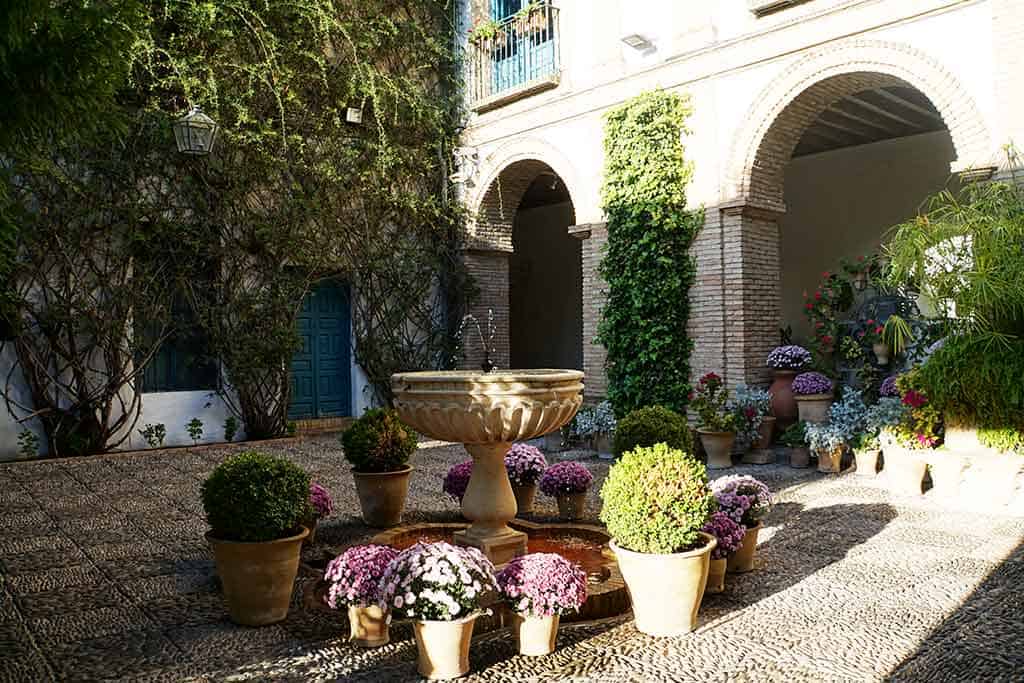
Covering 6,500 square meters, this Renaissance palace, home to the descendants of the Marquis of Villaseca and Viana is full to the brim with art and antique collections and has 12 delightful courtyard gardens (patios) to explore.
Opening Times: September-June Tuesday-Saturday 10 am-7 pm. July and August Tuesday-Saturday 9 am-3 pm
Price: €8 House & Courtyards, €5 courtyards only
Archaeological Museum
One of the most comprehensive archaeological museums in Spain, see artifacts from the Iberian, Roman, and Visigoth cultures, all of whom left their mark on Cordoba.
Opening Times: January-June Tuesday-Saturday 9 am-8.30 pm, Sunday 9 am-3.30 pm.
July-August Tuesday-Sunday 9 am-3 pm.
September-December Tuesday-Saturday 9 am-9 pm, Sunday 9 am-3 pm.
Price: €1.50
Take a Patio Walking Tour or Take a Bath!
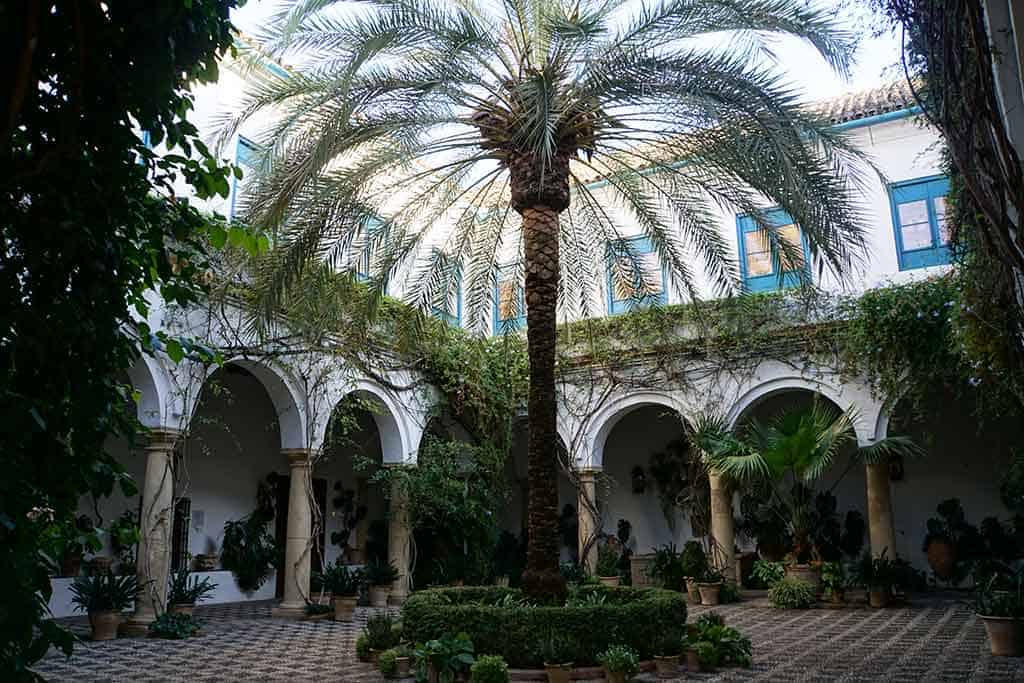
If you’re a flower fanatic who wants to see more of these beautiful patios, take the 2-hour patio walking tour around the San Basilio neighborhood with a local guide. Alternatively, why not have your very own Turkish Bath experience at one of the many traditional Hamman’s dotted around the city.
Click here to book your patios walking tour.
You might also be interested:
Things to do in Cordoba
How to spend one day in Cordoba
Our 10-day Andalucian road trip itinerary ends here having taken you around some of the most iconic as well as lesser-known villages, towns, and cities of this unique Spanish region, but don’t let us be the ones who make your road trip come to an end, use this guide as a starting point and carry on exploring!
You might also like: The best places to visit in Andalucia.

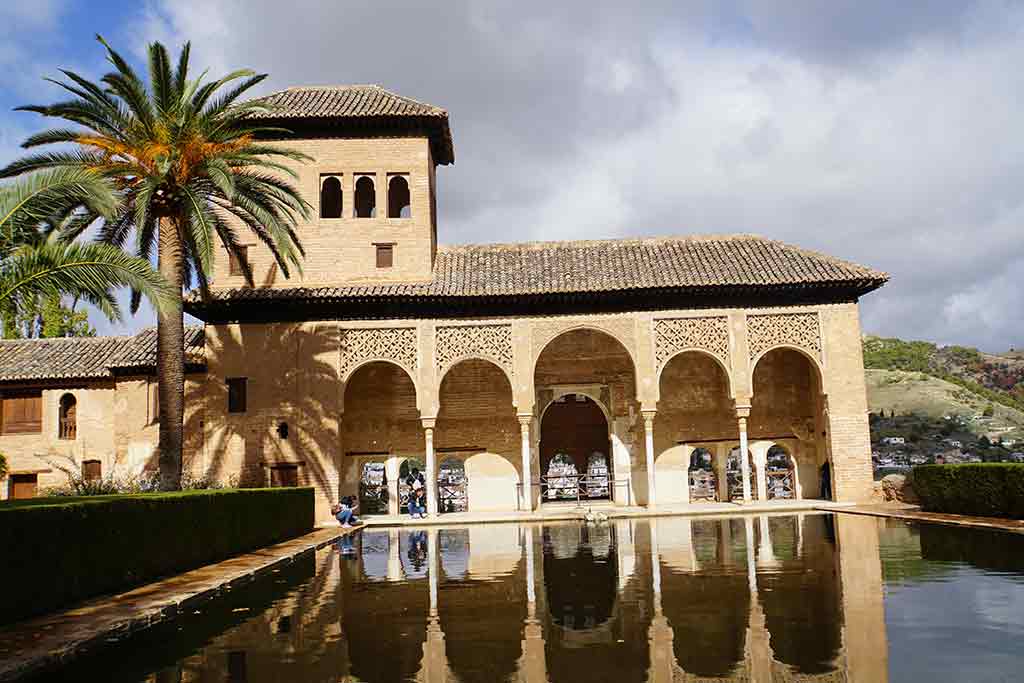
Hey there, great post. Last year I visited Spain with my husband but could only cover Seville in Andalucia. After the trip I realised should have spent more time exploring the southern part.